Discover the elegance of nature with Trees That Start with ‘Q’. From majestic Quercus to unique Quaking Aspen, uncover their allure, ecological importance and landscaping potential.
Trees are nature’s silent giants, standing tall and proud in our forests, parks and gardens. They clean our air, provide homes for wildlife and add beauty to our world. Today, we’re going to explore some fascinating trees that all start with the letter ‘Q’. These trees might not be as common as some others, but they’re just as important and beautiful. Let’s dive into the world of ‘Q’ trees and discover what makes them special!
1. Quercus (Oak Trees)
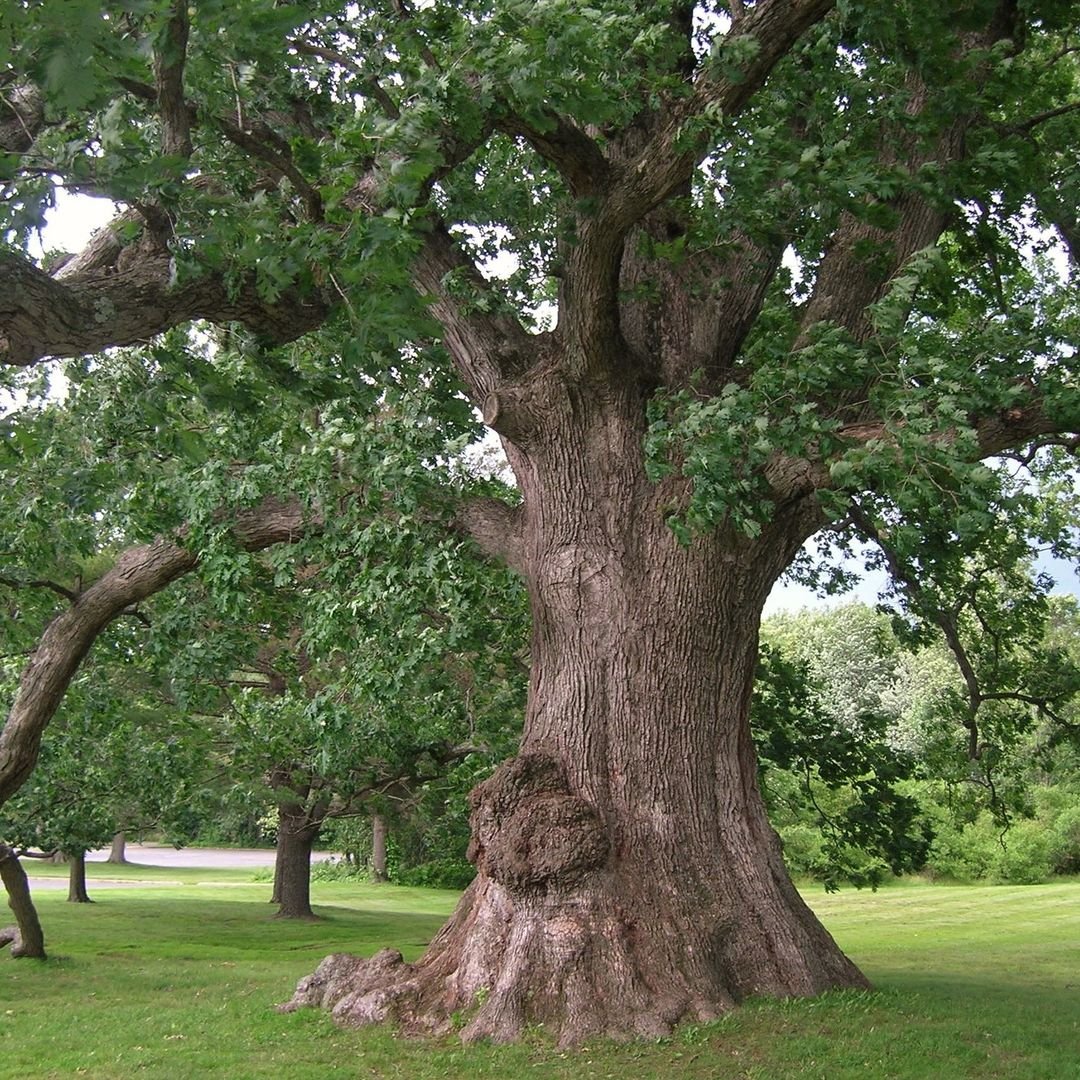
Here’s a concise information chart about oak trees (genus Quercus):
| Aspect | Information |
|---|---|
| Botanical Name | Quercus spp. |
| Common Name | Oak tree |
| Appearance | Deciduous or evergreen tree with a wide, spreading crown, often with deeply lobed, deciduous leaves or leathery, evergreen leaves. |
| Leaf Shape | Variable, depending on species; can be lobed, serrated, or entire margins. |
| Plant Type | Deciduous or evergreen broadleaf tree |
| Zones | Varies widely by species; USDA zones 3-10 depending on the type |
| Sun Exposure | Full sun |
| Soil Type | Well-drained soil; tolerant of various soil types including clay and sandy soils. |
| Watering | Regular watering, especially during establishment and dry periods. |
| Fertilization | Generally does not require heavy fertilization; benefits from organic matter in soil. |
| Growth Habit | Upright when young, spreading with age; some species are tall and straight, while others are more rounded or spreading. |
| Height/Spread | Varies widely by species; can range from 30-100 feet tall and wide. |
| Pests | Generally resistant to pests and diseases, but susceptible to oak wilt and oak leaf rollers in some regions. |
| Uses | Shade tree, lumber production, wildlife habitat, ornamental value in landscapes. |
| Special Features | Long-lived; distinctive acorns that provide food for wildlife; autumn foliage colors range from red to golden-yellow depending on species. |
When we think of trees that start with ‘Q’, Quercus, or oak trees, are often the first to come to mind. These majestic giants are found all over the world and are known for their strength and longevity.
Key Features:
- Lobed leaves that vary in shape depending on the species
- Acorns as fruit
- Often have wide, spreading canopies
Benefits:
- Provide food and habitat for many animals
- Wood is prized for furniture and construction
- Symbolize strength and endurance in many cultures
Growing Tips:
- Most oaks prefer full sun
- They need well-draining soil
- Be patient – oaks grow slowly but live for a very long time
Oaks are great choices for large landscapes where they have room to grow. They’re also excellent shade trees and can add significant value to a property over time.
2. Quaking Aspen (Populus tremuloides)
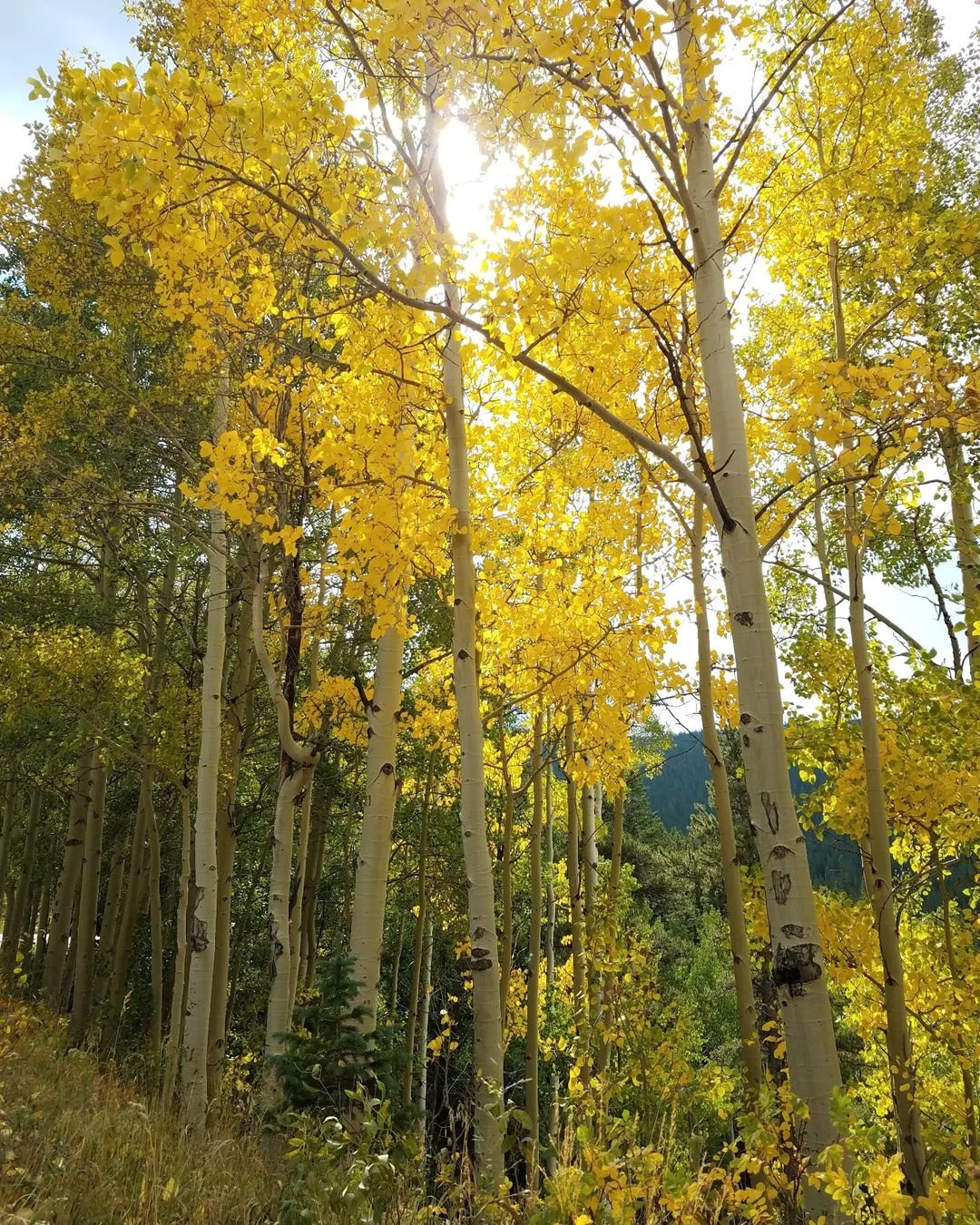
Here’s a concise information chart about Quaking Aspen (Populus tremuloides):
| Aspect | Information |
|---|---|
| Botanical Name | Populus tremuloides |
| Common Name | Quaking Aspen |
| Appearance | Deciduous tree with a slender trunk, smooth white bark marked with black scars, and small, round leaves that tremble in the slightest breeze. |
| Leaf Shape | Round, nearly circular, serrated edges. |
| Plant Type | Deciduous broadleaf tree |
| Zones | USDA zones 1-7 |
| Sun Exposure | Full sun to partial shade |
| Soil Type | Well-drained soil; tolerant of various soil types including rocky and poor soils. |
| Watering | Moderate watering; drought-tolerant once established. |
| Fertilization | Generally does not require fertilization; benefits from organic mulch. |
| Growth Habit | Upright and columnar when young, becoming more spreading with age. |
| Height/Spread | Typically 20-60 feet tall and 15-30 feet wide |
| Pests | Generally resistant to pests and diseases; can be affected by leaf spots and cankers. |
| Uses | Ornamental tree in landscapes, erosion control, wildlife habitat. |
| Special Features | Trembling leaves (hence the name “quaking”); golden-yellow fall foliage; clonal reproduction through root suckers forming large groves or “clones”. |
The Quaking Aspen is a unique tree known for its leaves that seem to “quake” or tremble in the slightest breeze.
Key Features:
- Round leaves that tremble in the wind
- Smooth, white bark
- Often grows in large colonies connected by a single root system
Benefits:
- Provides food and habitat for wildlife
- Helps prevent soil erosion
- Beautiful golden leaves in autumn
Growing Tips:
- Prefers cool climates
- Needs full sun
- Likes moist, well-draining soil
Quaking Aspens are perfect for adding movement and sound to your landscape. Their trembling leaves create a soothing rustle in the breeze.
3. Queensland Maple (Flindersia brayleyana)
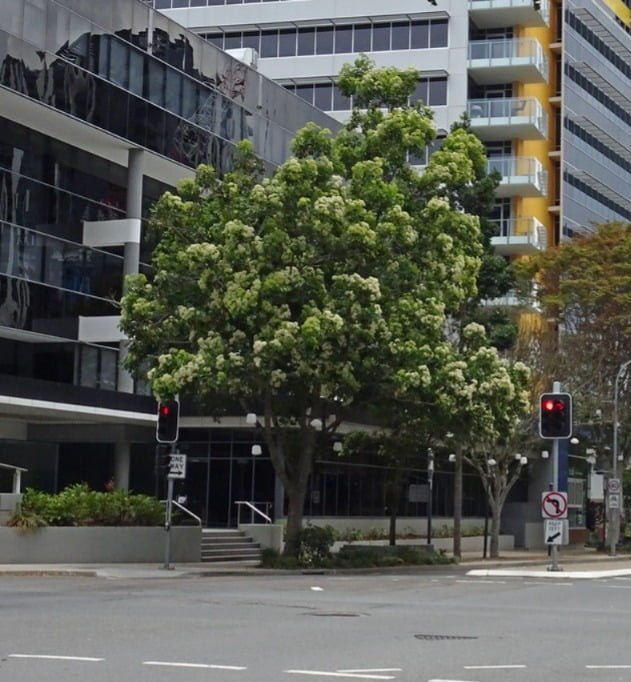
Here’s a concise information chart about Queensland Maple (Flindersia brayleyana):
| Aspect | Information |
|---|---|
| Botanical Name | Flindersia brayleyana |
| Common Name | Queensland Maple |
| Appearance | Evergreen or semi-evergreen tree with a tall, straight trunk, dense foliage, and compound leaves with 5-9 leaflets. |
| Leaf Shape | Compound, with 5-9 leaflets, lanceolate to ovate with serrated edges. |
| Plant Type | Evergreen or semi-evergreen broadleaf tree |
| Zones | USDA zones 10-11 |
| Sun Exposure | Full sun to partial shade |
| Soil Type | Well-drained, fertile soil |
| Watering | Regular watering, especially during dry periods. |
| Fertilization | Moderate fertilization, particularly nitrogen and potassium for growth. |
| Growth Habit | Upright and columnar when young, becoming more spreading with age. |
| Height/Spread | Typically 30-50 feet tall and 20-30 feet wide |
| Pests | Generally resistant to pests and diseases; may occasionally be affected by scale insects or leaf spots. |
| Uses | Shade tree, ornamental tree in landscapes, timber production. |
| Special Features | Attractive timber with a fine texture and light brown to pinkish color; clusters of small white flowers; seeds are winged and wind-dispersed. |
The Queensland Maple is a large tree native to Australia, known for its valuable timber.
Key Features:
- Large, compound leaves
- Produces capsules that split open to release winged seeds
- Can grow to be very tall in its native habitat
Benefits:
- Timber is used for furniture and musical instruments
- Provides shade in tropical climates
- Supports local wildlife in its native range
Growing Tips:
- Needs a tropical or subtropical climate
- Prefers well-draining soil
- Grows best in full sun to partial shade
While not commonly grown outside its native range, the Queensland Maple is an important tree in Australian forests and can be a beautiful addition to large tropical gardens.
4. Queen Palm (Syagrus romanzoffiana)

Here’s a concise information chart about Queen Palm (Syagrus romanzoffiana):
| Aspect | Information |
|---|---|
| Botanical Name | Syagrus romanzoffiana |
| Common Name | Queen Palm |
| Appearance | Feather-leaved palm with a single, slender trunk topped by a crown of pinnate leaves. |
| Leaf Shape | Pinnate, feather-like leaves. |
| Plant Type | Evergreen palm tree |
| Zones | USDA zones 9-11 |
| Sun Exposure | Full sun to partial shade |
| Soil Type | Well-drained soil; tolerates sandy soils |
| Watering | Regular watering, drought-tolerant once established |
| Fertilization | Requires occasional fertilization with a balanced fertilizer |
| Growth Habit | Solitary trunk, upright and symmetrical when young, becoming more rounded with age |
| Height/Spread | Typically 30-50 feet tall, 15-25 feet wide |
| Pests | Generally resistant to pests and diseases; may occasionally be affected by scale insects or palm aphids |
| Uses | Ornamental tree in landscapes, parks, and streetscapes |
| Special Features | Graceful appearance with arching fronds; produces small orange fruits that attract birds; tolerant of coastal conditions |
The Queen Palm is a popular ornamental palm tree known for its elegant, feather-like fronds.
Key Features:
- Long, feather-like fronds
- Smooth, gray trunk
- Produces small, orange fruits
Benefits:
- Adds a tropical look to landscapes
- Provides shade in warm climates
- Fruits are eaten by wildlife
Growing Tips:
- Needs full sun
- Prefers well-draining soil
- Requires regular watering, especially when young
Queen Palms are excellent choices for adding a tropical touch to landscapes in warm climates. They’re often used in street plantings and as focal points in gardens.
5. Quince (Cydonia oblonga)
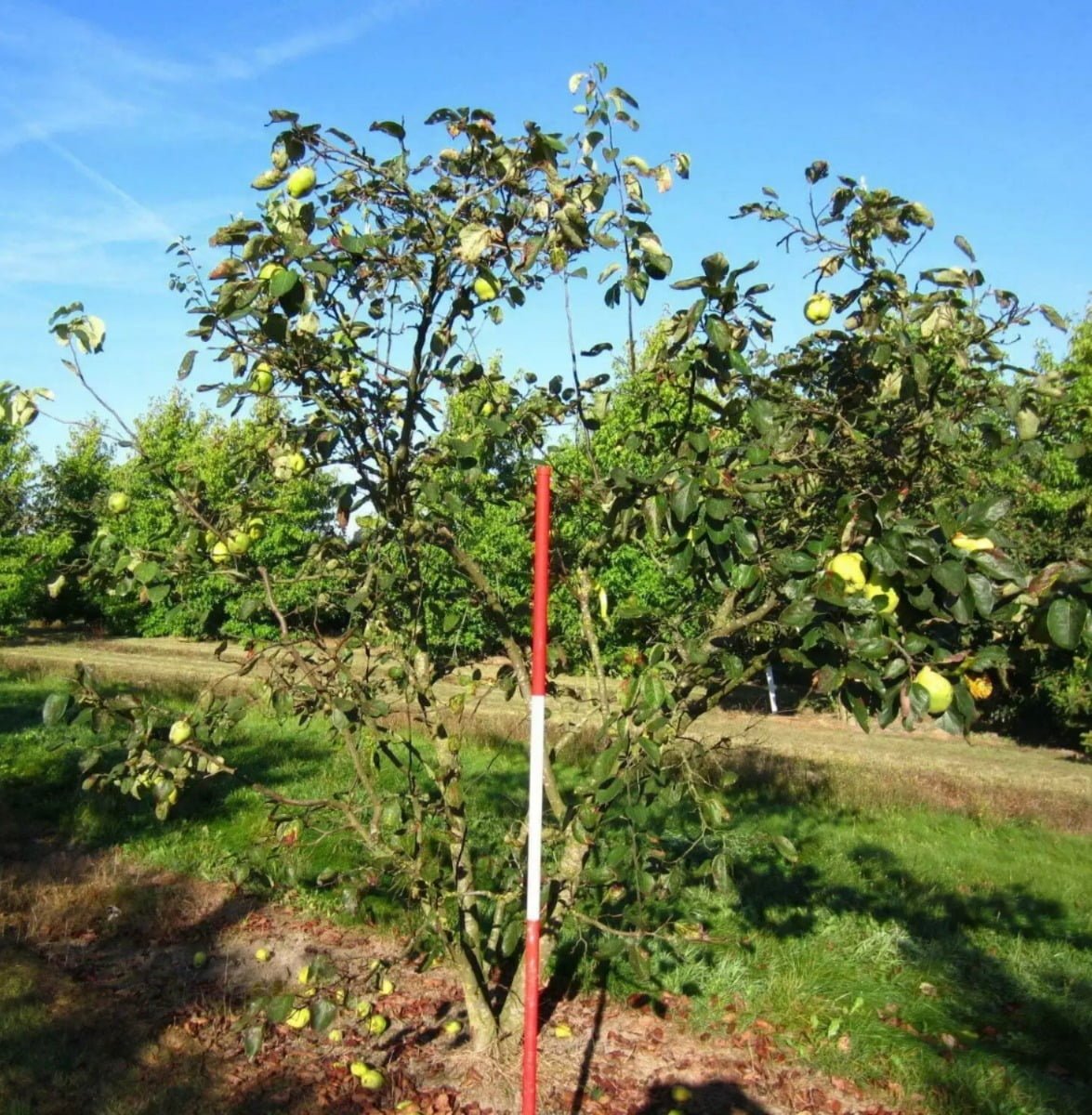
Here’s a concise information chart about Quince (Cydonia oblonga):
| Aspect | Information |
|---|---|
| Botanical Name | Cydonia oblonga |
| Common Name | Quince |
| Appearance | Deciduous shrub or small tree with a spreading habit, gray-brown bark, and ovate to oblong, glossy green leaves. |
| Leaf Shape | Ovate to oblong, entire margins. |
| Plant Type | Deciduous fruiting shrub or small tree |
| Zones | USDA zones 5-9 |
| Sun Exposure | Full sun to partial shade |
| Soil Type | Well-drained, fertile soil; tolerates slightly acidic to neutral pH |
| Watering | Regular watering during dry periods, especially when young |
| Fertilization | Moderate fertilization, especially phosphorus and potassium for fruiting |
| Growth Habit | Spreading, often multi-stemmed |
| Height/Spread | Typically 10-15 feet tall and wide |
| Pests | Generally resistant to pests and diseases; may be susceptible to fire blight and quince rust |
| Uses | Fruit production (edible quinces), ornamental value in gardens |
| Special Features | Edible fruits with a strong fragrance, used in preserves and cooking; attractive pink or white flowers in spring |
The Quince is a small tree or large shrub known for its tart, apple-like fruits.
Key Features:
- Pink or white blossoms in spring
- Large, yellow fruits in fall
- Often has a gnarled, twisted growth habit
Benefits:
- Fruits are used in cooking and preserves
- Beautiful spring blossoms
- Can be grown as an ornamental or fruit tree
Growing Tips:
- Needs full sun for best fruit production
- Prefers well-draining soil
- Benefits from regular pruning
Quince trees can be a unique addition to a home orchard or garden. While their fruits are usually too tart to eat raw, they make excellent jams and jellies.
6. Quickthorn (Crataegus monogyna)

Here’s a concise information chart about Quickthorn (Crataegus monogyna), commonly known as Hawthorn:
| Aspect | Information |
|---|---|
| Botanical Name | Crataegus monogyna |
| Common Name | Quickthorn, Hawthorn |
| Appearance | Deciduous shrub or small tree with a dense, thorny habit, gray-brown bark, and deeply lobed, glossy green leaves. |
| Leaf Shape | Oblong to ovate, deeply lobed, serrated edges. |
| Plant Type | Deciduous shrub or small tree |
| Zones | USDA zones 4-8 |
| Sun Exposure | Full sun to partial shade |
| Soil Type | Well-drained, fertile soil |
| Watering | Moderate watering, drought-tolerant once established |
| Fertilization | Generally does not require fertilization; benefits from organic mulch |
| Growth Habit | Dense and bushy |
| Height/Spread | Typically 15-25 feet tall and wide |
| Pests | Generally resistant to pests and diseases; may be affected by rust and aphids |
| Uses | Hedging plant, wildlife habitat (attracts birds), ornamental value in gardens |
| Special Features | Clusters of fragrant white flowers in spring, followed by small red berries; autumn foliage color ranges from yellow to orange-red |
Also known as hawthorn, the Quickthorn is a small tree or large shrub native to Europe.
Key Features:
- Small, lobed leaves
- White flowers in spring
- Red berries in fall
- Sharp thorns on branches
Benefits:
- Provides food and shelter for wildlife
- Often used in hedgerows
- Has medicinal uses in some cultures
Growing Tips:
- Tolerates a wide range of soil types
- Prefers full sun but can handle partial shade
- Very hardy and low-maintenance
Quickthorn is an excellent choice for wildlife gardens or natural hedges. Its dense, thorny growth provides safe nesting sites for birds.
7. Quebracho (Schinopsis balansae)
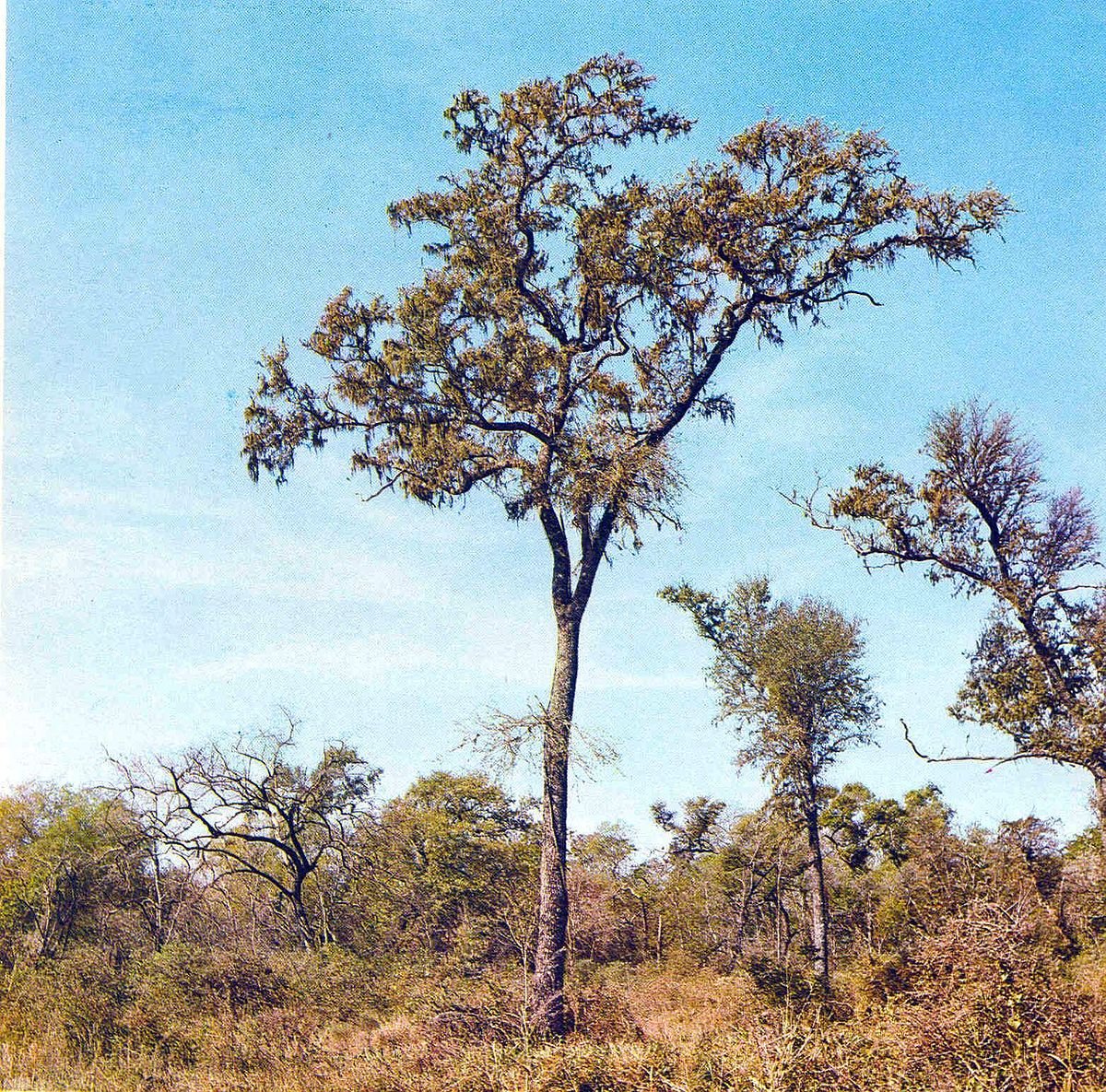
Here’s a concise information chart about Quebracho (Schinopsis balansae):
| Aspect | Information |
|---|---|
| Botanical Name | Schinopsis balansae |
| Common Name | Quebracho |
| Appearance | Evergreen tree with a rounded crown, dark brown to gray bark, and small, elliptical, leathery leaves. |
| Leaf Shape | Elliptical, leathery, entire margins. |
| Plant Type | Evergreen tree |
| Zones | USDA zones 9-11 |
| Sun Exposure | Full sun |
| Soil Type | Well-drained, sandy or loamy soil |
| Watering | Moderate watering; drought-tolerant once established |
| Fertilization | Minimal fertilization needed in natural settings; benefits from organic matter in soil |
| Growth Habit | Upright and symmetrical crown |
| Height/Spread | Typically 30-50 feet tall and wide |
| Pests | Generally resistant to pests and diseases; may be affected by scale insects or leaf spots |
| Uses | Timber production (dense and durable wood), tannin extraction for leather industry, ornamental value in landscapes |
| Special Features | Extremely hard and dense wood; bark and heartwood yield high tannin content used in tanning leather; known for its resilience and durability |
Quebracho is a tree native to South America, known for its extremely hard wood.
Key Features:
- Small, leathery leaves
- Very dense, hard wood
- Slow-growing and long-lived
Benefits:
- Wood is used for railroad ties and tannin production
- Important in its native ecosystem
- Very resistant to rot and insects
Growing Tips:
- Needs a tropical or subtropical climate
- Prefers well-draining soil
- Very drought-tolerant once established
While not commonly grown outside its native range, Quebracho is an important tree in South American forests and has significant economic value.
8. Quandong (Santalum acuminatum)

Here’s a concise information chart about Quandong (Santalum acuminatum):
| Aspect | Information |
|---|---|
| Botanical Name | Santalum acuminatum |
| Common Name | Quandong |
| Appearance | Small, evergreen shrub or tree with a dense, rounded canopy, and elliptical, leathery leaves. |
| Leaf Shape | Elliptical, leathery, entire margins. |
| Plant Type | Evergreen shrub or small tree |
| Zones | USDA zones 9-11 |
| Sun Exposure | Full sun |
| Soil Type | Well-drained, sandy or loamy soil |
| Watering | Regular watering, drought-tolerant once established |
| Fertilization | Minimal fertilization needed in natural settings; benefits from organic matter in soil |
| Growth Habit | Upright and bushy |
| Height/Spread | Typically 10-20 feet tall and wide |
| Pests | Generally resistant to pests and diseases |
| Uses | Edible fruit production (Quandong fruit), traditional medicinal uses, ornamental value in gardens |
| Special Features | Edible red fruit (Quandong fruit) with tart, peach-like flavor; culturally significant in Aboriginal Australian cuisine and medicine; aromatic wood used for carving and smoking |
The Quandong, also known as desert peach, is a small tree native to Australia.
Key Features:
- Small, elongated leaves
- Red fruits with a large seed
- Partially parasitic on the roots of other plants
Benefits:
- Fruits are edible and high in vitamin C
- Important food source for Aboriginal peoples
- Drought-tolerant and suitable for arid climates
Growing Tips:
- Needs full sun
- Prefers well-draining, sandy soil
- Requires a host plant to grow successfully
Quandong is an interesting tree for those in arid climates looking to grow native, edible plants. Its unique growing requirements make it a fascinating subject for gardeners.
9. Queensland Bottle Tree (Brachychiton rupestris)
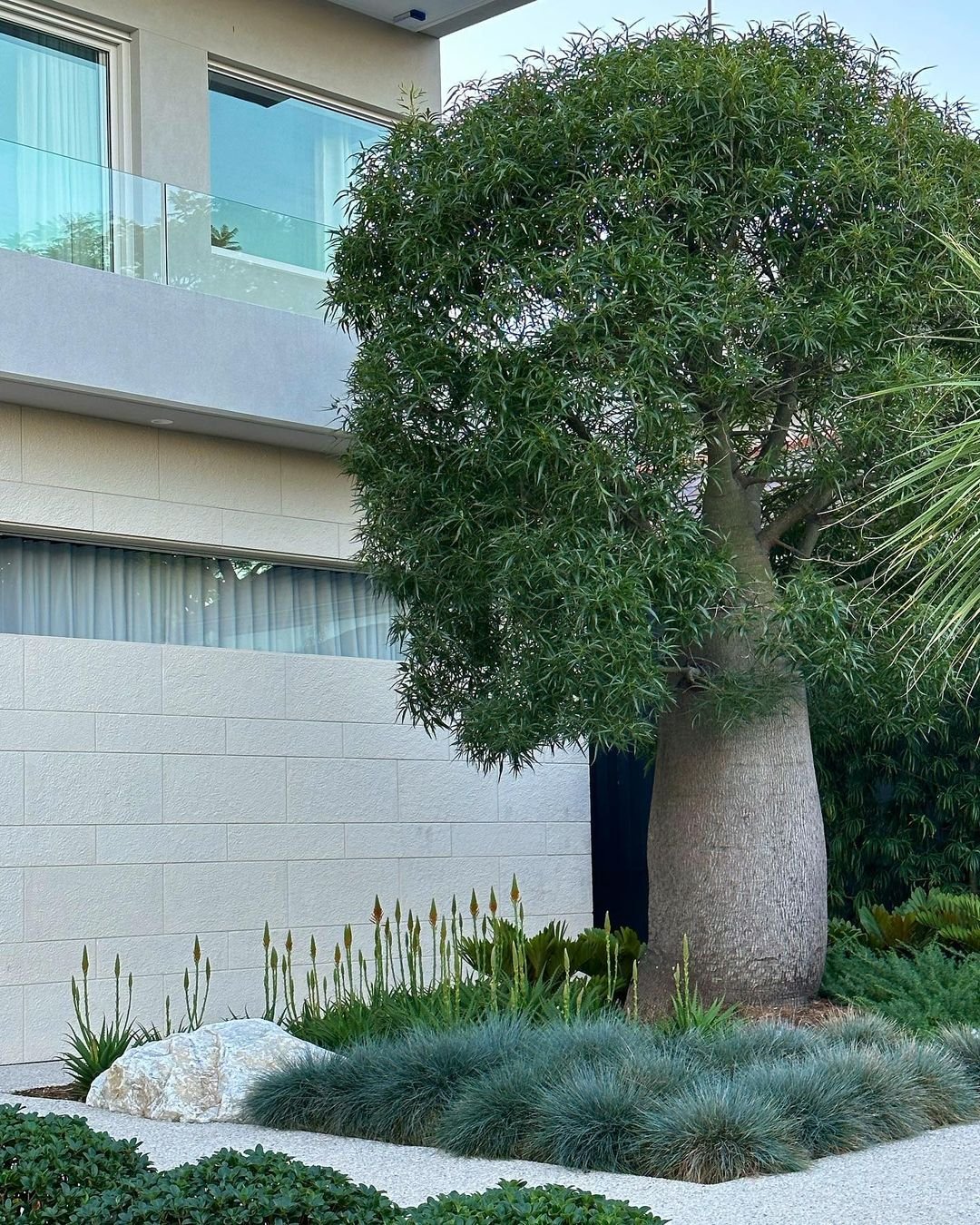
Here’s a concise information chart about Queensland Bottle Tree (Brachychiton rupestris):
| Aspect | Information |
|---|---|
| Botanical Name | Brachychiton rupestris |
| Common Name | Queensland Bottle Tree |
| Appearance | Deciduous tree with a swollen, bottle-shaped trunk, greenish bark, and large, lobed, glossy green leaves. |
| Leaf Shape | Large, lobed, glossy green leaves. |
| Plant Type | Deciduous tree |
| Zones | USDA zones 9-11 |
| Sun Exposure | Full sun to partial shade |
| Soil Type | Well-drained soil; tolerant of various soil types including sandy and loamy soils |
| Watering | Regular watering, drought-tolerant once established |
| Fertilization | Minimal fertilization needed; benefits from organic mulch |
| Growth Habit | Upright and symmetrical when young, becoming more spreading with age |
| Height/Spread | Typically 20-50 feet tall and wide |
| Pests | Generally resistant to pests and diseases; may be susceptible to scale insects or leaf spot diseases |
| Uses | Ornamental tree in landscapes, parks, and streetscapes; drought-tolerant feature tree |
| Special Features | Distinctive swollen trunk that stores water; clusters of bell-shaped cream to yellow flowers; seed pods containing fluffy fibers used for crafts |
The Queensland Bottle Tree is known for its distinctive bottle-shaped trunk.
Key Features:
- Swollen, bottle-shaped trunk
- Small, lance-shaped leaves
- Loses its leaves during dry periods
Benefits:
- Unique ornamental value
- Drought-tolerant
- Historically used as a water source by Aboriginal peoples
Growing Tips:
- Needs full sun
- Prefers well-draining soil
- Very drought-tolerant once established
The Queensland Bottle Tree is an excellent choice for xeriscaping or as a unique focal point in warm-climate gardens.
10. Quamash (Camassia quamash)

Here’s a concise information chart about Quamash (Camassia quamash):
| Aspect | Information |
|---|---|
| Botanical Name | Camassia quamash |
| Common Name | Quamash, Camas |
| Appearance | Perennial bulbous plant with slender, upright stems bearing spikes of star-shaped, blue to purple flowers. |
| Leaf Shape | Linear, grass-like leaves |
| Plant Type | Perennial bulbous plant |
| Zones | USDA zones 4-8 |
| Sun Exposure | Full sun to partial shade |
| Soil Type | Moist, well-drained soil; tolerant of various soil types including clay and sandy soils. |
| Watering | Regular watering during growth and flowering |
| Fertilization | Light fertilization in spring with balanced fertilizer |
| Growth Habit | Upright and clumping |
| Height/Spread | Typically 1-2 feet tall, spreading gradually |
| Pests | Generally resistant to pests and diseases; may be susceptible to slugs and snails |
| Uses | Ornamental plant in gardens and naturalized settings; edible bulbs historically used by Native American tribes |
| Special Features | Showy spikes of blue to purple flowers in spring; attracts pollinators; bulbs were historically an important food source for Indigenous peoples |
While not technically a tree, Quamash is a flowering plant that’s worth mentioning in our ‘Q’ list.
Key Features:
- Produces tall spikes of blue flowers
- Grass-like leaves
- Grows from a bulb
Benefits:
- Beautiful ornamental plant
- Edible bulbs (when properly prepared)
- Important to Native American cultures
Growing Tips:
- Prefers full sun to partial shade
- Needs moist soil
- Goes dormant in summer after flowering
While not a tree, Quamash can be a beautiful addition to a native plant garden or wildflower meadow.
Trees that start with ‘Q’ might not be as common as some others, but they’re certainly no less fascinating. From the mighty Quercus (oak) that symbolizes strength and longevity, to the unique Quandong that thrives in the Australian desert, these trees demonstrate the incredible diversity of the plant world.
Whether you’re looking to add shade, fruit or simply beauty to your landscape, consider one of these ‘Q’ trees. Remember, when planting any tree:
- Choose a species that’s well-suited to your climate and soil conditions
- Give the tree enough space to grow to its full size
- Provide proper care, especially in the first few years after planting
By choosing the right tree and caring for it well, you can enjoy its beauty and benefits for many years to come. Trees are more than just plants – they’re living legacies that can last for generations. So why not start your own legacy with a ‘Q’ tree?
Remember, every tree planted is a step towards a greener, healthier planet. Whether you choose a common oak or a rare Queensland Bottle Tree, you’re making a positive impact on the world around you. Happy planting!